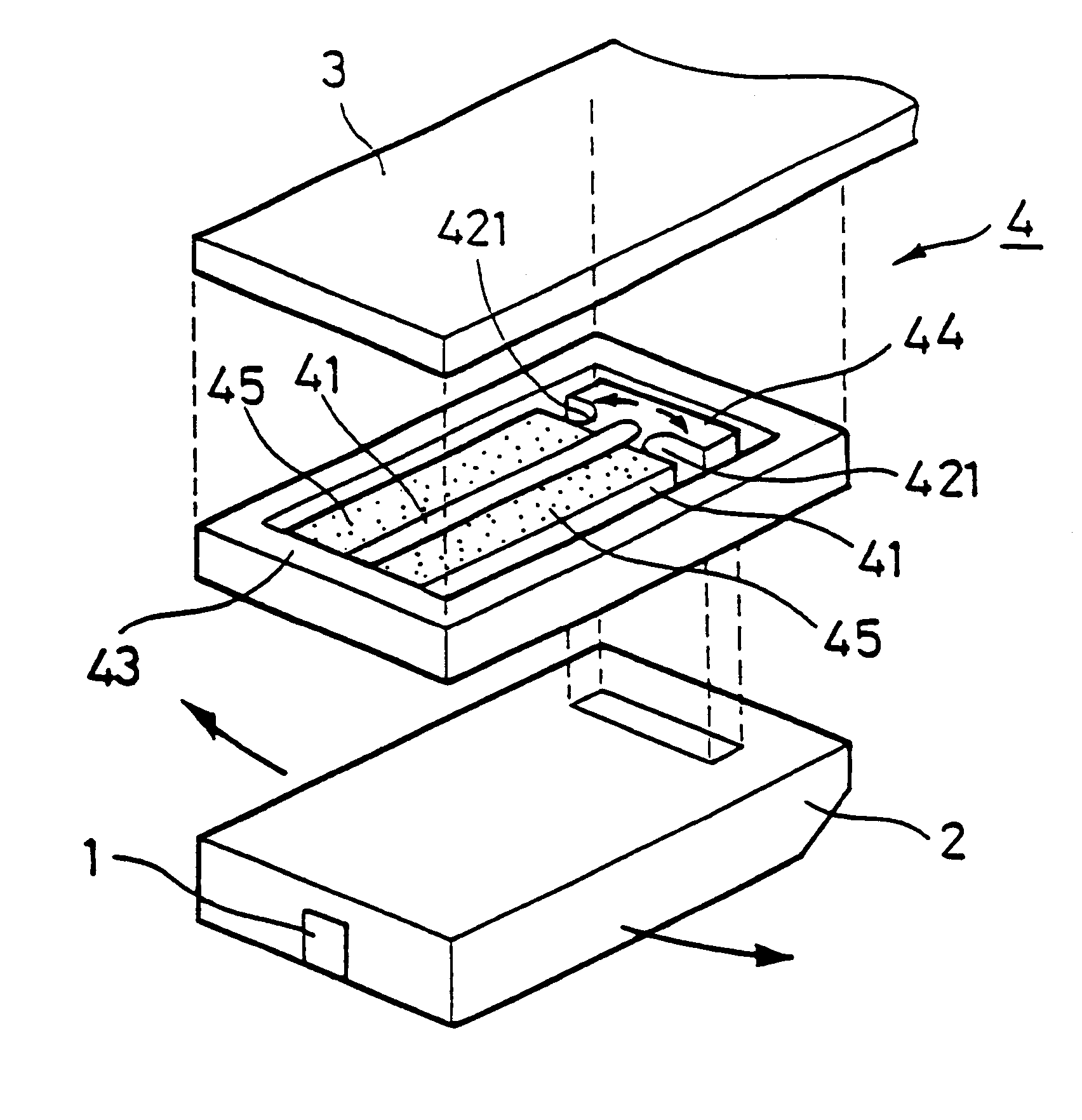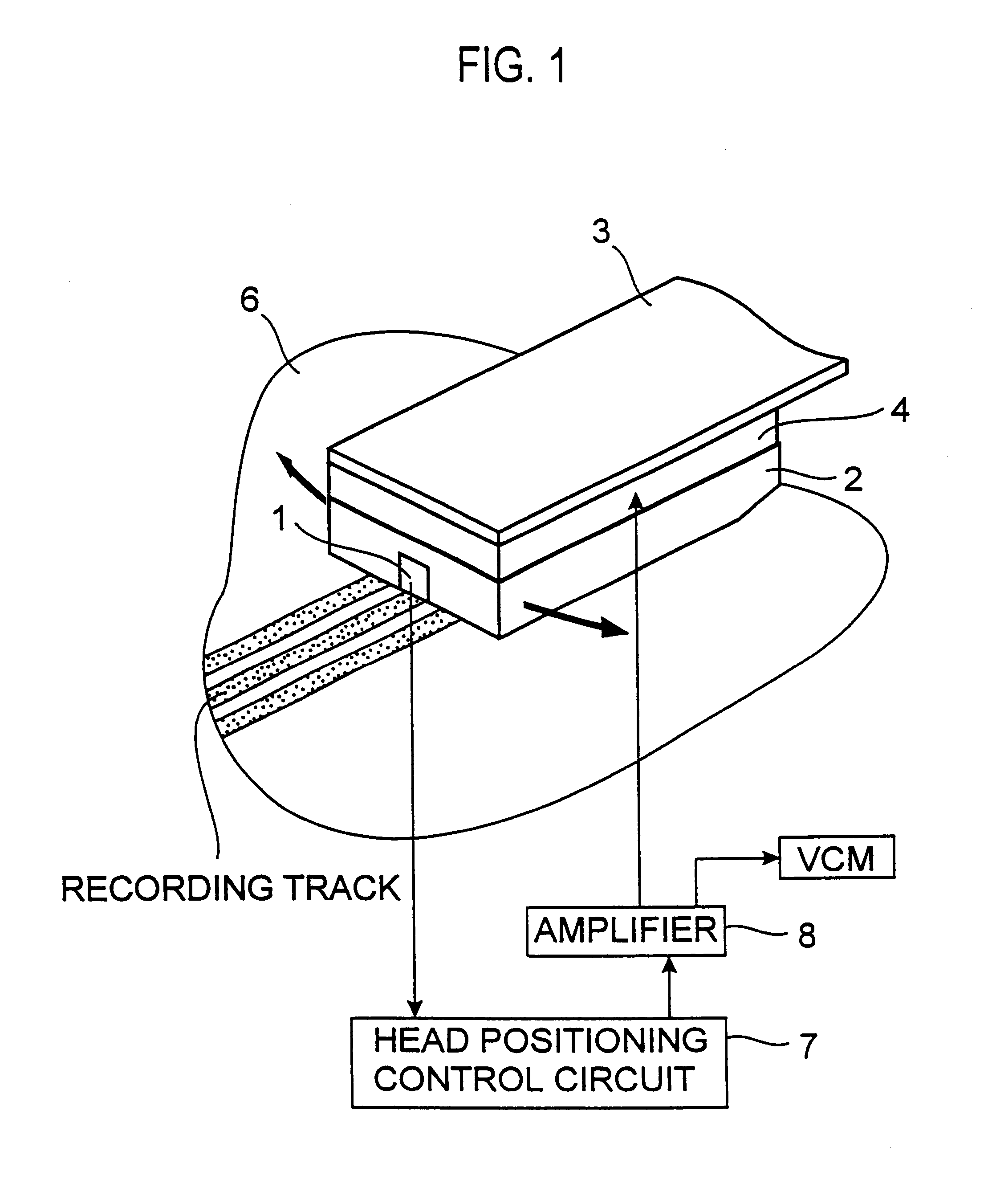A problem with a magnetic disk drive is a track misregistration that is an offset between the magnetic head and the recording tracks caused by vibrations of the disk medium surface in
synchronism or a
synchronism with the rotation of the disk medium, eccentricity of the disk medium,
thermal expansion and extraneous vibrations of the magnetic disk drive including the magnetic head and disk medium, etc.
This track misregistration leads to problem, for instance, erasion upon recording of
signal information stored in adjacent tracks due to overwriting, a drop upon
reproduction of the level of signals outputted from the track concerned, and a quality drop of output signals due to the entrance of signals from adjacent tracks in the form of
crosstalk noises.
A grave problem attendant to the conventional magnetic disk drive is, however, that there is a limit in positioning precision, especially recording track-following precision due to the swing motion of the whole of a massive structure comprising the magnetic head, arm and coil, the movement of the slider via the resilient suspension, and the fact that the bearing providing the center of the swing motion has in itself friction resistance, eccentricity, and so on.
For these reasons, the problems associated with a conventional magnetic head positioning mechanism become even more troublesome.
As the read / write track
pitch becomes as narrow as about 1 .mu.m while such a
flying height is maintained, however, several problems arise, for instance, erasion upon recording of
signal information stored in adjacent tracks due to a recording
magnetic field leakage, and an S / N degradation upon
reproduction due to a drop of
signal level absolute output.
As the
flying height decreases, however, it is required to more severely control the flying characteristics (fluctuations in the
flying height) of the magnetic head upon seek control or read / write track-following control, and the smoothness of the disk medium.
For these magnetic heads taking aim at achieving much higher recording densities, it is very difficult to conduct seek control or read / write track-following control.
However, this approach, too, is unavoidably affected by vibrations of the suspension because the slider is driven via the suspension having resiliency as in the case of the aforesaid VCM positioning mechanism.
Thus there is a limit in positioning precision improvements.
However, it is found that with the electrostatic force actuator it is difficult to generate driving force large enough to displace the slider, and with the electromagnetic force actuator there is concern that the
magnetic signal on a disk medium is affected by flux leakage.
A problem common to both actuators is that they are sensitive to extraneous disturbances because the slider must be held in place by means of a support member that has small resiliency and can be deformed by electrostatic force, and electromagnetic force generated from the actuators.
Nonetheless, the magnetic head is susceptible to displacement in the flying direction (fluctuations in the flying height) due to
assembly errors, etc.
Assembly steps required for the
assembly structure incur some considerable cost, and the
assembly structure renders it difficult to increase its rigidity, resulting in a mechanical robustness drop problem associated with bonded parts.
In addition, the
assembly structure becomes poor in displacement characteristics due to the need of drawing interconnecting lines out of the electrodes of the piezoelectric elements, and costs much as well thanks to its complexity.
The third embodiment, too, poses similar problems, for instance, variations in displacement characteristics due to assembly errors.
For such a structure, it is difficult to place the size of the displacement generating means and the size of the spaces in which they are fitted under tolerance control.
For piezoelectric elements having a very small displacement amount, it is undesirable that a gap exists between them because there is loss or a variation of the amount of displacement transmitted, or otherwise no displacement is transmitted to the actuator whatsoever.
To eliminate such a gap, high-precision assembly techniques are need, but not only do they involve technical difficulties but incur some considerable expense as well.
In addition, no sufficient robustness is achievable because some load is applied on the piezoelectric element, resulting in a reduction of its life, and a premature degradation of its performance.
When an
adhesive layer usually comprising an organic resin, etc. is used for the bonding of the piezoelectric element, the following problems arise.
Transmission loss occurs because the displacement of the piezoelectric element gives rise to deformation of the
adhesive layer; bonding reliability drops because some load is applied on the
adhesive layer upon the displacement of the piezoelectric element; and displacement transmitted from the piezoelectric element to the electromagnetic transducer element through the adhesive layer is susceptible to a secular change because the adhesive force (fixing force), and rigidity of the adhesive layer changes depending on the aforesaid load, and ambient conditions (high temperature,
high humidity, and so on).
In this arrangement, too, there is again a reliability drop because the piezoelectric elements deflect the
metal thin sheets through an adhesive layer.
A problem with this flying head is, therefore, that the size of the piezoelectric element must be increased to increase the amount of displacement of the head body.
Another problem with this flying head is that a part of the flying surface is susceptible to deformation, and displacement as well.
This leads to further problems that the flying characteristics are unstable, and the read / write characteristics are unstable as well due to fluctuations in the spacing between the head body and the medium.
Accordingly, when positioning is effected with respect to recording tracks, the same problems as mentioned with reference to the flying type magnetic head arise.
 Login to View More
Login to View More  Login to View More
Login to View More 


